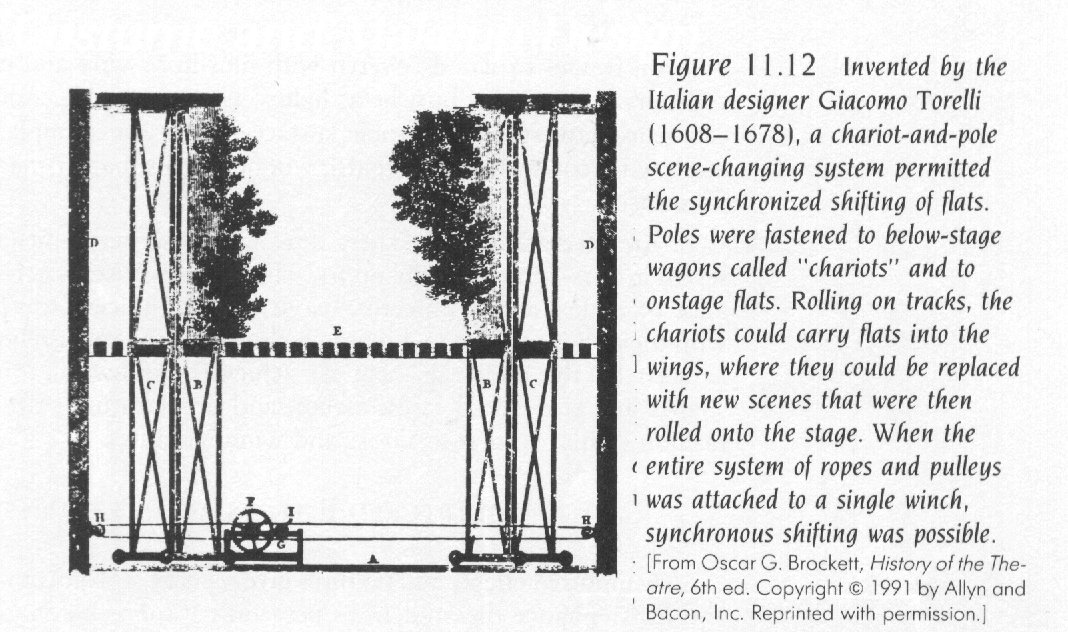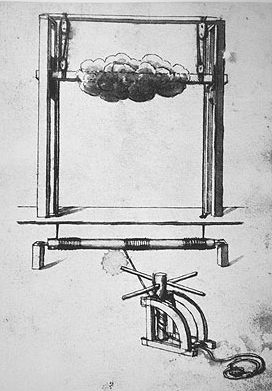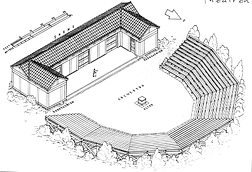Computers quickly modernized lighting, allowing lighting technicians to actually shift and change some lights during the show rather than fix them all before hand and turn them on or off on a bulky switch board. Microphones and sound technology also grew and became computer controlled in theaters; wireless mics were first available in the 1970’s. Finally, theater has been using multi-media techniques to create new dramatic forms and make older forms better.
For a long time, computers were simply ways to control stagecraft, keeping lights, sound, sets, and scenery moving and working correctly, if doing that much. Lights, sound, scenery, set-moving and building, and costuming are all considered part of theater technology. While many techniques have been modified rather than changed over the years, artists come together and share new ideas, ways of using theater technology, and creating better ways of doing things. Websites and unions help bring theater technicians together.1
On the other hand, people are using technology to create new methods of theater. The Wooster Group uses digital media and movies in their plays while the Gertrude Stein Theater Repertory uses computer to visualize productions and are now working with “digital puppetry,” which combines computer generated images with live performance.2 Improvisational Theater troupe Neutrino actually makes a short improv movie; they begin in theater, take suggestions from the audience, race to the streets to shoot a video, edit it quickly, then show the audience. These groups, and others, use media to present large portions of their productions or just to enhance live productions.
Neutrino Videos:
Warning: Language and Crude Humor in the following video
Another form of theater has gone to the web. Desktop Theater is a theatrical form which takes place in chat rooms, using avatars as characters and actors reading their lines while interacting with spontaneous members in the chat room. The idea, conceived by Adriene Jenik and Lisa Brenneis who are both media artists, was first displayed in a digitalized version of Samuel Beckett's Waiting for Godot. The play featured icons to represent Gogo and Didi, both with hats, who entered a chat room called "The Moor" and proceeded to act out waitingforgodot.com, their version of the famous play. The performance was captured and each chatty nuance saved for future generations. The play makers performed “live” for other members of the chat room and even had a few participate. A guy calling himself Muscleman interacted with Didi and Gogo quite a bit, even changing his name to Godot by the end of the play. It was an interesting twist (and Beckett is probably rolling in his grave) but the show demonstrated the viability of purely online plays—today, the play might be done for a live audience via web cam and Jenik and Brenneis have directed several more desktop theaters, expanding the number of actors, sets, and interactions with the audience as they developed their art form further.3 4 5
Clip from waitingforgodot.com
Even traditional theater is doing some really cool and revolutionary things these days. Spider-Man: Turn of the Dark employs technology that allows Spider Man to move around the theater on his famous web-ropes. There is also a massive in-air battle between Spidey and the Green Goblin directly over the audience.
(The song is kind of silly but the effects are really cool)
Legally Blond: The Musical uses lighted-columns to frame the set and keep the actors from rattling around on a massive stage while Wicked’s classic hydraulic-lift may not be new technology but is combined with fantastic music and neat fog effects and lighting to make it more realistic and moving.
Theater has always defined its time and technology from simple machines to computer-powered effects has driven theater forward. Theater exists partially to push boundaries and try new things; technology is one front theater constantly moves forward. Today, theater employs computers to control and create stage craft and sometimes to even create entire plays. The challenge remains in keeping theater the spontaneous, organic art form which enthralls so many people rather than letting it become the flawless productions already on movie screens. With groups like Desktop Theater and Neutrino, theater will continue to push boundaries with computer technology and hopefully remain the art form that has captured imaginations for centuries.
2 Henry Harvey, “Technology in Theater,” Hentry Harvey Thesis, http://www.henryharvey.com/technotheater.html, (accessed July 21, 2011).
3Jenik, Adriene. Desktop Theater. http://ajenik.faculty.asu.edu/desktoptheater/desktoptheater_content/main/files/m_1.htm. (Accessed July 20, 2011).
4Jenik, Adriene. "Desktop Theater: Keyboard Catharsis and the Masking of Roundheads."TDR 45, No. 3 (Autumn, 2001): 95-112. http://www.jstor.org/stable/1146914 . (Accessed July 19, 2011).
5Rosenberg, Scott. “Clicking for Godot.” Salon| 21st. http://www.salon.com/21st/feature/1997/10/02godot.html. (Accessed July 20, 2011).





